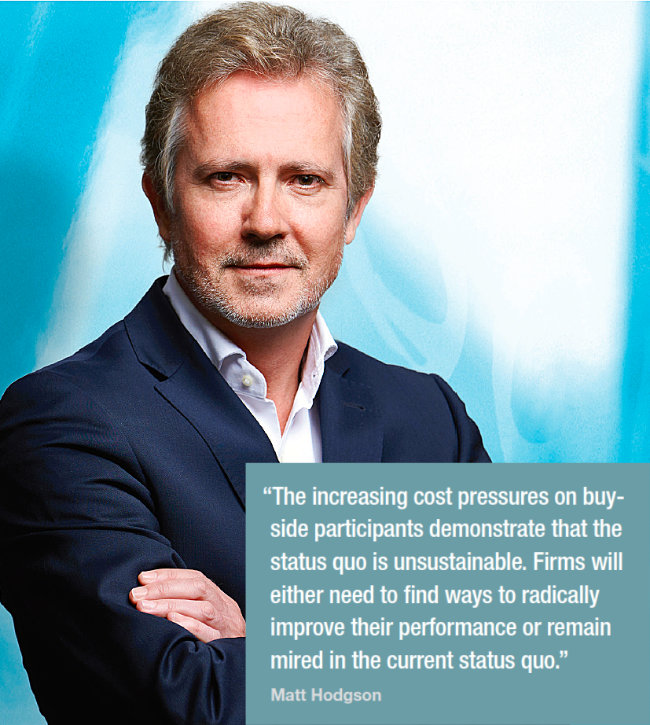With the rise of low-cost ETFs, so-called ‘smart-beta’ strategies and the struggling performance of many actively managed funds, buy-side firms are coming under increasing fee pressure. In response, says Matt Hodgson, founder of Mosaic Smart Data, leading firms are investing significantly in data analytics to drive performance and profitability improvements.
For buy side and sell side alike, the markets are an ever-more competitive environment. Through a combination of greater choice, greater sophistication and the drive from regulators, clients are becoming much more demanding on costs. This trend has been combined with the fact that many active and quantitative strategies have struggled to generate significantly higher returns than cheaper passive alternatives, making their cost structures more difficult to justify.
As a result, many firms are becoming trapped in a price war which is forcing their fees down. In fact, a number of larger firms are turning to ‘zero cost’ fund models. These models don’t charge the investor but make their money by lending assets to short-sellers. While such an approach may well have a place in the modern fund management landscape, it will certainly not be for every firm.
Another approach, which many of the leading asset managers are already turning to, is to look inwards at the vast flows of transaction data moving through the institution. By understanding every facet of their business at the atomic level, firms can begin to drive a return to profitability.
Tapping into the transaction data iceberg
Every day the world generates 2.5 quintillion bytes of data, according to IBM. The notion that data can be valuable to a capital markets institution is nothing new. Firms spend millions on market data feeds, with the market for data and analytics now worth more than $30 billion a year, up 7% from the previous year. A recent study by PwC estimated that 84% of capital markets firms expected to be running advanced data analytics within the next five years.
However, fewer firms have the required level of data literacy, or the ability to access, the value in the transaction data which they themselves generate through their interactions with the market, from price formation to trade confirmation and settlement.
It is imperative to see the interdisciplinary collaboration between engineering, quant finance and data science as a strategic weapon. Typically, most firms see them as separate and distinct verticals, and cross-pollination and driving horizontal integration between them remains challenging. This is where much of the value lies and tying them together in teams results in the most exciting outcomes.
For example, when a firm hires teams of data scientists, how can they possibly add value if they don’t understand the business and how their insights could be built into the workflow of users?
Most buy-side firms are sitting on a gold-mine of data, but it is siloed across different desks, venues and asset classes. Once this data is aggregated across all transaction channels and third-party feeds and analysed in real-time, the buy-side firm can begin to draw out a number of important and highly valuable insights from the data.
Let’s take, for example, questions around execution quality. For a buy-side trader, the quality of a transaction only becomes apparent after the event. The amount of information that the trader can access in real-time is extremely limited. This means that, when it comes to a trade which the trader might have time to handle over a longer time period, there isn’t much scope for adjusting strategy part way through.
Real-time data analytics which are built on the combination of the firms’ own transaction data supplemented with market data can show the trader, in real-time, exactly how the market is reacting to their trading activity. It allows them to understand whether the market is moving away from them when they trade with certain dealers or whether their counterparties are internalising their flow, which is having no impact on the market at all. Clearly the latter is the preferred option.
This kind of analysis, which we call transaction quality analysis, goes beyond best execution analysis and gives a much finer grained and ‘360 degree’ view of the transaction.
Crucially, delivering these insights in real-time can allow traders to adjust course throughout the day and learn much more quickly from the data. This is absolutely critical for today’s automated business environment. And if the full organisation – from traders to investment strategists, quants, managers, monitoring, compliance and credit teams – are using the same data source, the efficiency gains will be dramatic.
Model-driven trading
Delivering analytics which traders can view and act upon is an important step forward for buy-side firms wishing to improve execution performance. However, the really powerful improvements come when this real-time analysis is combined with machine learning algorithms.
Here we are referring to ‘smart’ analytics which can learn from the data it analyses and begin to make predictions about the trading environment. The more data these models have, the better they function as they learn from their successes and failures to become extremely sophisticated prediction engines. This model-driven approach is the same one as is used every day by world-leading companies such as Google and Netflix.
This shift to the model-driven approach moves analytics beyond a reactive, post-trade activity which seeks to understand what happened, to a proactive activity which is able to inform the firm on likely outcomes.
The analysis provided by these models can empower traders to make proactive decisions and trade with a far more sophisticated, probabilistic view of the markets and their counterparties. In low touch trading environments, these models can also be used to fuel automated strategies by making proactive decisions which guide the automated trading algorithms to make the best execution decisions.
The increasing cost pressures on buy-side participants demonstrate that the status quo is unsustainable. Firms will either need to find ways to radically improve their performance or remain mired in the current status quo, which will continue to squeeze margins until only those firms who can trade at huge scale are able to make meaningful returns.
Smart data + smart people = smart outcome
A data analytics platform’s success isn’t just contingent on what’s under the hood – the front end also matters enormously. A modern buy-side firm with a young, tech-savvy team will experience a much higher level of engagement from its employees if the systems it deploys are as intuitive and user-friendly as consumer software such as iOS and Android.
At Mosaic Smart Data we ensure our products look, feel and perform like the world’s leading consumer platforms. This is without question a direction that all enterprise software is headed. Millennials are the future leaders of buy-side organisations, and they will not tolerate antiquated and cumbersome systems and software.
Naturally, our User Centred Design is underpinned by highly sophisticated data science and cutting-edge technology. Our smart data analytics provides both augmentation and automation. For human traders, augmenting decision making with smart suggestions and real-time insights has quickly moved from being a nice-to-have to becoming a core necessity. With the drive to automation, these streaming metrics and suggestions quickly become the API building blocks for low touch execution algorithms.
We are also highly research-driven, which includes adoption and measurement of impact. As such we have an R&D partnership with the European Space Agency as well as employing Oxford University’s Head of Mathematical Finance as our Chief Scientific Advisor. We believe that bringing the best products to market requires R&D risk but also collaboration with academia. Of course, not all initiatives will provide significant pay-offs but the ones that do can generate enormous value.
The future of data analytics for the buy-side will not be a case of man vs machine, but instead the recognition of the enormous benefits of both working in unison.
©TheDESK 2019
©Markets Media Europe 2025













